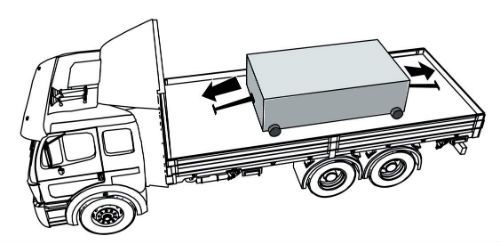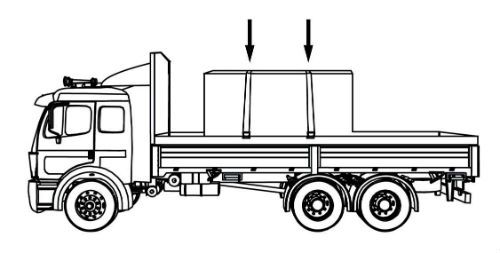CDL Practice Tests: Flatbed Cargo Securement
Choose A Section:
Go!Cargo securement for a load weighing 37,000 lbs must be able to withstand a minimum forward braking force of:
- 18,500 lbs
- 10,000 lbs
- 7,400 lbs
- 29,600 lbs
How well must the securement system work? (Section 1.3)
Each cargo securement system must be able to withstand a minimum amount of force in each direction.
- Forward Force = 80% of cargo weight when braking while driving straight ahead.
- Rearward Force = 50% of cargo weight when accelerating, shifting gears while climbing a hill, or braking in reverse.
- Sideways Force = 50% of cargo weight when turning, changing lanes, or braking while turning.
-
Upward Force = 20% of cargo weight when traveling over bumps in the road or cresting a hill.
- This requirement is satisfied when the cargo is "Fully Contained."
In cargo securement, what is a 'cleat' defined as?
- A short piece of material, usually wood, nailed to the deck to reinforce blocking.
- A tapered piece of material, thick at one end and thin at the other.
- A tapered or wedge-shaped piece used to secure round articles against rolling.
- Part of the structure, fitting, or attachment on a vehicle or cargo to which a tiedown is attached.
Cleat:
A short piece of material, usually wood, nailed to the deck to reinforce blocking.
To secure a cubic-shaped boulder, how many tiedowns are required, at minimum?
- 5
- 1
- 2
- 3
Special Circumstances: Securing a Cubic-Shaped Boulder
The securement of a cubic-shaped boulder must meet these requirements in addition to the other large boulder requirements in Section 13.

Secure each boulder individually with at least two chain tiedowns placed side-to-side across the vehicle.
Place tiedowns as closely as possible to the hardwood blocking used to support the boulder.
What is a pallet used for?
- A vertical barrier across a vehicle to prevent forward movement of cargo.
- A vertical barrier across the front of the deck of a vehicle to prevent forward movement of cargo.
- A platform or tray on which cargo is placed so that it can be handled as an article. (Same as "Skid")
- A waterproof sheet used to cover cargo.
Pallet:
A platform or tray on which cargo is placed so that it can be handled as an article. (Same as "Skid")
The North American Cargo Securement Standard cover vehicles weighing:
- 26,001 lbs
- Over 4,500 lbs
- Over 10,000 lbs
- Less than 10,000 lbs
North American Cargo Securement Standard
What does the Standard cover? (Section 1.1)
- Commercial vehicles (including a combination of vehicles) that are operated on a highway and have a gross vehicle rating over 4,500 kg (10,000 lb.)
Vehicles
When securing paper rolls with friction mats as a primary method:
- All of these answers.
- Make sure friction mats are completely covered by the roll.
- The friction mat should stick out from underneath the roll in the opposite direction for which it is providing securement.
- The friction mat should stick out from underneath the roll in the direction it is providing securement.
Requirements for friction mats

If a friction mat is used to provide the principal securement for a paper roll, insert the friction mat so that it sticks out from beneath the footprint of the roll in the direction in which it is providing securement.
When securing an intermodal container on a chassis, what is the maximum allowable vertical travel when secured?
- 1 inch
- 2 1/2 inches
- 2 inches
- 1/2 inch
Securing devices must restrain the container from moving more than:
- 1.27 cm (1/2 in) forward.
- 1.27 cm (1/2 in) rearward.
- 1.27 cm (1/2 in) to the right.
- 1.27 cm (1/2 in) to the left.
- 2.54 cm (1 in) vertically.
A chock is defined as:
- A crosswise load bearing structural component, particularly a part of a log bunk.
- A structure, device, or another substantial article placed against or around an article to prevent horizontal movement of the article.
- A short piece of material, usually wood, nailed to the deck to reinforce blocking.
- A tapered or wedge-shaped piece used to secure round articles against rolling.
Chock:
A tapered or wedge-shaped piece used to secure round articles against rolling.
In terms of cargo securement, what is a 'well'?
- A female housing fixed to the side or ends of a vehicle to receive a stake or peg, and may also be used as an anchor point.
- A rail along the side of a vehicle that protects the side of the vehicle from impacts.
- A device placed between the deck of a vehicle and car or between articles of cargo, intended to provide greater friction than exists naturally between these surfaces.
- The depression formed between two cylindrical articles when they are laid with their eyes horizontal and parallel against each other.
Well:
The depression formed between two cylindrical articles when they are laid with their eyes horizontal and parallel against each other.
What is a cab shield?
- The depression formed between two cylindrical articles when they are laid with their eyes horizontal and parallel against each other.
- A structure, device, or another substantial article placed against or around an article to prevent horizontal movement of the article.
- A vertical barrier placed directly behind the cab of a tractor to protect the cab in the event cargo should shift forward.
- A vertical barrier across the front of the deck of a vehicle to prevent forward movement of cargo.
About The Flatbed Cargo Securement CDL Manual
Studying the flatbed cargo securement CDL manual is not a requirement for getting your CDL permit or license. It is required knowledge for flatbed drivers.
Some questions you should be able to answer for flatbed cargo securement:
- What is the minimum Working Load Limit of a tiedown used to secure logs?
- What is the minimum weight of a shipment of paper rolls that would require specific securement requirements?
- When securing concrete pipe over 45 inches loaded crosswise, which direction must the tiedowns on the front half of the load run?
- What is a cab shield?
- When securing concrete pipe over 45 inches loaded crosswise, which direction must the tiedowns on the rear half of the load run?
- What is a dunnage bag?
- Who is responsible for inspecting securing devices and cargo within the first 50 miles?
- How many tiedowns are required on a stack of shortwood loaded crosswise?
- What is the minimum working load limit of each tiedown used to secure crushed or flattened vehicles?
- Define 'bolster'
- What is a hook-lift container?
- When a tiedown is attached directly to the cargo, what is the ideal angle where it attached to the vehicle?
What is a securing device?
Any device specifically manufactured to attach or secure cargo to a vehicle or trailer:
- Synthetic Webbing
- Chain
- Wire rope
- Manila rope
- Synthetic rope
- Steel strapping
- Clamps and latches
- Blocking
- Front-end structure
- Grab hooks
- Binders
- Shackles
- Winches
- Stake pockets
- D-rings
- Webbing ratchet
- Bracing
- Friction mat
What is a tiedown?
A combination of securing devices that forms an assembly that:
- Attaches cargo to, or restrains cargo on a vehicle.
- Is attached to anchor point(s).

Some tiedowns are attached to the cargo and provide direct resistance to restrain the cargo from movement.

Some tie-downs pass over or through the cargo. They create a downward force that increases the effect of friction between the cargo and the deck. This friction restrains the cargo.
 Related Cargo Securement Terms That Every Driver Should Know:
Related Cargo Securement Terms That Every Driver Should Know:
-
Tiedown:
A combination of securing devices which form an assembly that attaches cargo to, or restrains cargo on, a vehicle or trailer, and is attached to anchor point(s).
-
Contained:
Cargo is contained if it fills a sided vehicle, and every article is in contact with or sufficiently close to a wall or other articles so that it cannot shift or tip if those other articles are also unable to shift or tip.
-
Blocking:
A structure, device, or another substantial article placed against or around an article to prevent horizontal movement of the article.
How should tiedowns be attached?
Tiedowns can be used in two ways:
-
Attached to the cargo:
- Tiedowns attached to the vehicle and attached to the cargo.
- Tiedowns attached to the vehicle, pass through or aroundan article of cargo, and then are attached to the vehicle again.
-
Pass over the cargo:
- Tiedowns attached to the vehicle, passed over the cargo, and then attached to the vehicle again.
Tiedown placement:

Place the tiedown as close as possible to the spacer.
Position the tiedowns as symetrically as possible over the length of the article.

Position the tiedowns to preserve the integrity of the article.







 TT On Facebook
TT On Facebook